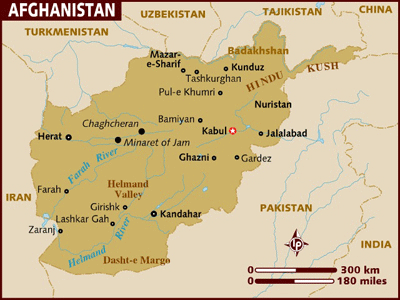Visits to Afghanistan in 2006 & 2007
 On the bottom of his page there is an 8 minute 38 second slideshow
of 129 photos taken during my trips to Afghanistan in 2006 (Kabul) and 2007 (Mazar-e-Sharif) with the
Travelers Century Club.
On the bottom of his page there is an 8 minute 38 second slideshow
of 129 photos taken during my trips to Afghanistan in 2006 (Kabul) and 2007 (Mazar-e-Sharif) with the
Travelers Century Club.
Afghanistan is a unique and fascinating place, and difficult to evaluate on the basis of two short trips. All serious travelers are drawn here. There are few places on Earth where 25 centuries of technology and thinking can be experienced in the same place. The main value of this report is the slideshow itself.
The safest parts of the country are in the north-west where Afghanistan borders the “stan” countries of central Asia. They are moderate Muslim countries and I have visited them all. The most dangerous parts are in the south-east, the border areas with Pakistan.
General Themes
Afghanistan is a poor and dusty country where people are working hard to survive and recover from almost a generation of warfare. Most adult women are still wearing the burka, but they seem to be a bit lighter than under the Taliban. You see women window shopping for fancy dresses they can now wear at home. Girls are back in school.
As you look at the photos, you will notice several themes: the dust, the friendly often dirty children, newly planted trees, war-damaged buildings - even the parliment building, new buildings, new cars, a new mosque, simple stones to mark graves, security men (who like having their photos taken), "no gun" signs, people harvesting carrots inside Kabul, new water wells, animals used for transport, food laid on burlap on the ground, markets and streets dominated by men, etc.
There are more photos of Ahmad Shah Massoud, the national hero of Afghanistan (video tribute), than Harvard-educated President Karzai. Massoud was assassinated on September 9, 2001, as part of the 9/11 attack plan on the USA.
Kabul (2006)
I flew into Kabul in October 2006 and stayed at the Serena Hotel, the best hotel in the country. Six people were killed there when it was bombed in January 2008 in spite of its outstanding security. At the Serena, I met Claudia Roth, former co-chair of the Green Party in the Germany. She explained that the Afghan Foreign Minister had lived in Germany for many years before returning to Afghanistan.
In Kabul, you see billboards advertizing many foreign aid projects. The contrasts between the modern and the traditional are stark. Why does the Kabul Museum have old Cadillacs and a western stagecoach in its backyard? The golf course with dirt greens is a complete surprise, and the tent school is a typical example of the make-do environment.
The delightful Babur’s Garden, built for the founder of the Mughal Empire, is being restored with workmen mixing mortar in an ancient way. Babur ruled India from Kabul in the early 16th century.
Mazar-e-Sharif (2007)
I crossed overland from Uzbekistan in a small van in May 2007 and visited Mazar-e-Sharif and Balkh. The dust was so painful in my eyes that I had to remove my contact lens. Men were digging out a truck stuck in a small sand dune on the highway. The famous Blue Mosque is in Mazar-e-Sharif, and Balkh was the winter headquarters of Alexander the Great.
The Blue Mosque, the most important mosque in Afghanistan, is one of the reputed burial sites of Ali, the son-in-law of Mohamad and the founder of the Shiite branch of Islam. There after prayers the men quickly formed two long rows so a coffin could be carried between the rows. To save space I left out photos of the ancient ruins in Balkh, but some of the scenes there with old, wizened, turbaned men on donkeys are the same ones seen by Alexander the Great.
Slideshow
The slideshow (11.8Mb) takes about a minute to load. When the background changes to black it is ready to play,
click on the small arrow on the bottom left side of the slideshow to start. If desired, click to pause or resume.
The controls also allow a full screen show, but it will be a bit fuzzy. If controls not visible, point to video window.
|
|